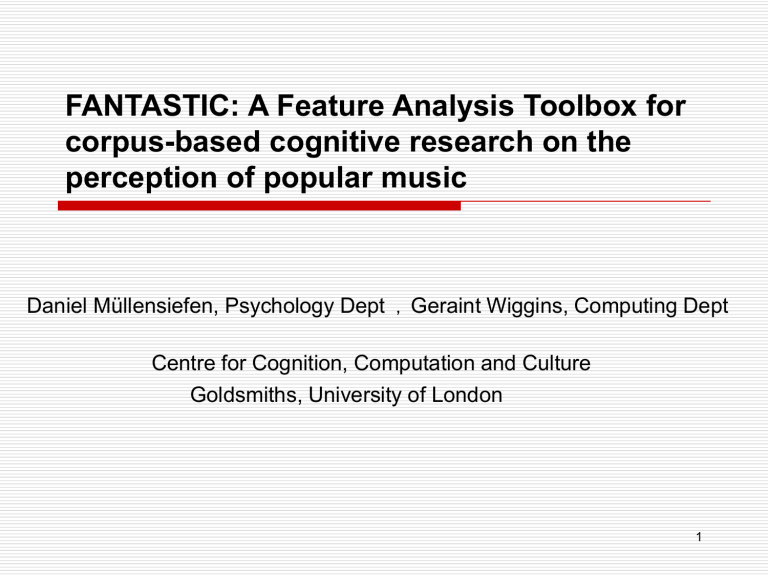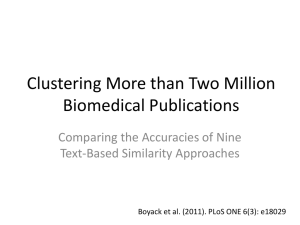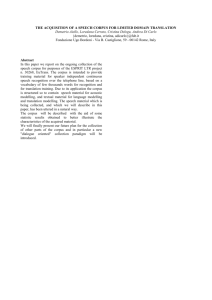FANTASTIC: A Feature Analysis Toolbox for corpus

FANTASTIC: A Feature Analysis Toolbox for corpus-based cognitive research on the perception of popular music
Daniel Müllensiefen, Psychology Dept , Geraint Wiggins, Computing Dept
Centre for Cognition, Computation and Culture
Goldsmiths, University of London
1
Summary of a Research Project
M4S: Modelling Music Memory and the
Perception of Melodic Similarity (2006-2009)
Question : How do Western listeners perceive melody?
Domain : Western commercial pop music
Method : Computational modelling
2
Outline
1.
Results o Music Cognition o Popular Music Research
2.
Methods o Computing Features with FANTASTIC o Modelling Music Knowledge from a Corpus (2 nd order features)
3.
Background o Similar Approaches/Systems o Questions to be addressed
3
Results: Music Cognition I
Memory for Melodies:
Are there structural features that make melodies more memorable?
How are listeners using musical knowledge to perform implicit and explicit memory tasks?
4
Results: Music Cognition I
0.4
Modelling explicit and implicit memory performance in a recognition paradigm (M üllensiefen, Halpern & Wiggins, in prep.)
0.35
0.3
0.25
R^2 0.2
0.15
0.1
0.05
0
1st ordrer features
2nd order features
(testset)
2nd order features (pop corpus)
Expl. memory
(AUC)
Impl. memory
(old-new)
Results: o Memory performance is partially explained by musical features o Implicit memory is better explained by raw features or local context o Explicit memory draws on domain knowledge and features that are distinctive wrt corpus
5
Results: Music Cognition II
Montreal Battery of Amusia, MBEA,
(Peretz et al., 2003)
:
What makes some test items more difficult than others?
What information do subjects actually use to process tasks?
6
Results: Music Cognition II
Modelling item difficulty in MBEA
(Stewart, M üllensiefen & Cooper, in prep)
Results: o 70-80% of item difficulty can be explained with as few as three musical features o Relation between item difficulty and features is often non-linear o Some subtests don’t measure what they are believed to measure (e.g. scale)
7
Results: Pop Music Research I
Court cases of music plagiarism:
Are court decisions predictable from melodic structures?
What musical information is used in court decisions?
8
Results: Pop Music Research I
1.0
0.9
0.8
0.7
0.6
0.5
0.4
0.3
0.2
0.1
0.0
Ed it
Di st
.
Model court decisions on melody plagiarism
(M üllensiefen & Pendzich, 2009)
Tv
.e
qu al
Tv
.p
la in tif f
Tv
.d
ef en da nt
Accuracy
AUC
Results: o Court decisions can be closely related to melodic similarity o Plaintiff’s song is often frame of reference o Statistical information about commonness of melodic elements is important
9
Results: Pop Music Research II
Melodic structure and popularity:
Does popularity correlate with certain structural features of a tune?
10
Results: Pop Music Research II
Identify features of commercially successful songs on Revolver
(Kopiez & M üllensiefen, 2008)
Criterion for commercial success: Entered charts as cover version (yes/no) p (chart_entry 1)
1
1 e (772.4 + 141.2 pitch_range - 4731.3 pitch_entropy)
Results: o 2 features (pitch range and entropy) are sufficient for fully accurate classification into successful / unsuccessful songs o Plausible interpretation as compositional exercise: Invent a chorus melody such that it has a large range and uses only few pitches much more frequently than the majority of its pitches
11
Method
Two Components
i .
abs .
std
i
p i
p
2
N 1
2.83
Feature Computation Knowledge from a large corpus of music
12
Features
Implemented features inspired by concepts from o Descriptive statistics o Music Theory o Music Cognition o Music Information Retrieval o Computational Linguistics
13
Feature Computation
Pre-requisite: Transformation from notes to numbers
Melody: Sequence of tuples
(notes) with time and pitch information: n
i
( t i
, p i
)
14
Summary Features
Cognitive Hypothesis: Listeners abstract summary representation of short melodies during listening
Evidence: o Feature-based description and analysis of tunes since Bartok
(1936) in o Folk song research (Steinbeck, 1982; Jesser, 1990; Sagrillo, 1990) o Computational analysis (Eerola & Toiviainen, 2004; McKay, 2005) o Summarising mechanism in visual perception (Chong &
Treisman, 2005)
Feature format: Value that represents particular aspect of melody
15
Summary Features
32 summary features based on: o Pitch o Pitch intervals o Duration ratios o Global extension o Contour o Implicit tonality
Ex. 1: Pitch range (p.range): p .
range max( p ) min( p )
Ex. 2: Standard deviation of absolute intervals (i.abs.std):
i .
abs .
std
i
p i
p
2
N 1
16
Method: Summary Features
Ex. 3: Relative number of direction changes in interpolated contour representation (int.cont.dir.changes) int .
cont .
dir .
changes
1 sgn
sgn
x i 1
x i
x
1 i 1
17
m-type Features
Cognitive Hypothesis: Listeners use literal representation of short subsequences of melody for processing
Inspiration: Text retrieval and computational linguistics
Evidence: o Sequence learning for pitches and music (e.g. Saffran et al.,
1996, 2000; Pearce & Wiggins, 2005, 2006; Loui & Wessel,
2006) o Sequence learning as a general mechanism
Format of mtype: String of digits (similar to “word type” in linguistics) representing pitch intervals and duration ratios
18
m-type Features
• m-types only from within melodic phrases
• Pitch intervals: Classified into 19 classes, preserving diatonic information
• Duration ratios: Classified into 3 classes (Drake & Daisy, 2001), perceptual asymmetric class boundaries (Sadakata et al., 2006)
• Mtype length: Parallel handling of various lengths (1,…,5) m-type of length 2:
“s1e_s1e” m-type of length 4:
“s1q_s1l_s1q_s1l”
19
m-type Features
Format of m-type feature: Number that represents distributions of mtypes of various lengths in melody mean .
Honores .
H 1 n
100 log N
1.01
V
20
M4S publications on features
Melodic Contour (M üllensiefen, Bonometti, Stewart & Wiggins, 2009;
Frieler, M üllensiefen & Riedemann, in press; Müllensiefen & Wiggins, under review)
Phrase segmentation (Pearce, M üllensiefen & Wiggins, 2008; accepted)
Harmonic content (Mauch, M üllensiefen, Dixon & Wiggins, 2008;
Rhodes, Lewis & M üllensiefen, 2007)
Melodic accent structure (Pfleiderer & M üllensiefen, 2006;
Müllensiefen, Pfleiderer & Frieler, 2009)
21
Method: Using a music corpus
The M4S Corpus of Popular Music
(M üllensiefen, Wiggins &
Lewis, 2008)
:
14,067 high-quality MIDI transcriptions
Representative sample of commercial pop songs from 1950 - 2006
Complete compositional structure (all melodies, harmonies, rhythms, instrumental parts, lyrics)
Some performance information (MIDI patches, some expressive timing)
22
Using a music corpus:
2nd order summary features
Cognitive Hypothesis: Listeners encode commonness of feature value
Evidence: Statistical learning in music and language (e.g.
Huron, 2006; Pearce & Wiggins, 2006; Rohrmeier,
2009)
Method: Replacing feature values by
relative frequencies (categorical and discrete features)
frequency density from kernel smoothing (continuous features)
23
Using a music corpus:
2nd order summary features
Continuous features
Categorical / discrete features
24
Using a music corpus:
2nd order m-type features
Cognitive Hypothesis: Listeners are sensitive to commonness of mtypes
Method: Use frequency information on m-types from large corpus
Example: Normalised distance of m-type frequencies in melody and corpus (mtcf.norm.log.dist)
=> measures whether uncommon m-types are used rather frequently in melody mtcf .
norm .log .
dist
i
m
T F
i
D F
i
TF
m with TF
' i
m
log
2 log
TF
2
i
m
TF
i
m
25
Similarity from features
Three similarity models:
Euclidean distance
Gower’s coefficient
Corpus-based similarity
26
Corpus-based similarity
Cognitive Hypothesis: Similarity perception is based on features of melodies and melody corpus as frame of reference
Idea: Derive similarity from distance on cumulative distribution function
Combine features: By entropyweighted averaging
k , C
m i
, m j
l l
x i
1 f
C
l
l l
x
1 j f
C
l
27
Method: Summary
Feature ANalysis Technology Accessing STatistics In a Corpus:
FANTASTIC
Open source tool box for computational analysis of melodies*
58 features currently implemented
Different similarity models based on features
Ideas from: Descriptive statistics, music theory, music cognition, computational linguistics, music information retrieval
2 feature categories: Summary features and m-type features
Context modelling via integration of corpus: 2nd order features
* http://www.doc.gold.ac.uk/isms/m4s/?page=Software%20and%20Documentation
28
Method: Yet unexplored
Effects of different corpora
Don’t use raw but cognitively weighted pitches (e.g. perceptual accents)
Don’t reduce: Use information from m-types directly for
similarity measurement
classification
Create a space / model of feature correlations for corpus
(similar to LSA)
29
Background: Similar approaches
Folk Song Research / Ethnomusicology
Bart ók (1936), Bartók & Lord (1951)
Lomax (1977)
Steinbeck (1982)
Jesser (1992)
Sagrillo (1999)
Popular Music Research
Moore (2006)
Kramarz (2006)
Furnes (2006)
Riedemann (in prep.)
Computational / Cognitive Musicology
Eerola et al. (2001, 2007)
McCay (2005)
Huron (2006)
Frieler (2008)
30
Background: Questions to be addressed
Popular Music Research
Questions: How does melodic structure relate to
Popularity and selection processes
Style
Transmission processes
Specific types of behaviour (e.g. singalongability)
Value attribution (originality, creativity)
Music Cognition Research
Questions: How does melodic structure relate to
Memory performance and memory errors
Similarity judgements
Expectancy
Preference / aesthetic judgements
31
FANTASTIC: A Feature Analysis Toolbox for corpus-based cognitive research on the perception of popular music
Daniel Müllensiefen, Psychology Dept Geraint Wiggins, Computing Dept
Centre for Cognition, Computation and Culture
Goldsmiths, University of London
32
Four main functions
Computing features (summary and m-type): compute.features()
Computing 2 nd order summary features: compute.corpus.based feature.frequencies()
Computing 2 nd order m-type features: compute.m.type.corpus.based.features()
Computing feature-based similarity: feature.similarity()
33








